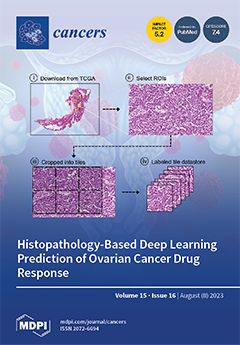Primary liver cancer (PLC) can be classified in hepatocellular (HCC), cholangiocarcinoma (CCA), and combined hepatocellular-cholangiocarcinoma (cHCC-CCA). The molecular mechanisms involved in PLC development and phenotype decision are still not well understood. Complete deletion of
Ppp2r5d, encoding the B56δ subunit of Protein Phosphatase 2A
[...] Read more.
Primary liver cancer (PLC) can be classified in hepatocellular (HCC), cholangiocarcinoma (CCA), and combined hepatocellular-cholangiocarcinoma (cHCC-CCA). The molecular mechanisms involved in PLC development and phenotype decision are still not well understood. Complete deletion of
Ppp2r5d, encoding the B56δ subunit of Protein Phosphatase 2A (PP2A)
, results in spontaneous HCC development in mice via a c-MYC-dependent mechanism. In the present study, we aimed to examine the role of
Ppp2r5d in an independent mouse model of diethylnitrosamine (DEN)-induced hepatocarcinogenesis.
Ppp2r5d deletion (heterozygous and homozygous) accelerated HCC development, corroborating its tumor-suppressive function in liver and suggesting
Ppp2r5d may be haploinsufficient.
Ppp2r5d-deficient HCCs stained positively for c-MYC, consistent with increased AKT activation in pre-malignant and tumor tissues of
Ppp2r5d-deficient mice. We also found increased YAP activation in
Ppp2r5d-deficient tumors. Remarkably, in older mice,
Ppp2r5d deletion resulted in cHCC-CCA development in this model, with the CCA component showing increased expression of progenitor markers (SOX9 and EpCAM). Finally, we observed an upregulation of
Ppp2r5d in tumors from wildtype and heterozygous mice, revealing a tumor-specific control mechanism of
Ppp2r5d expression, and suggestive of the involvement of
Ppp2r5d in a negative feedback regulation restricting tumor growth. Our study highlights the tumor-suppressive role of mouse PP2A-B56δ in both HCC and cHCC-CCA, which may have important implications for human PLC development and targeted treatment.
Full article






